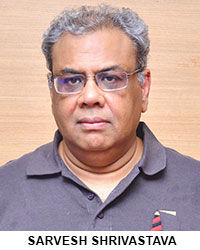 – Sarvesh Shrivastava is founder and managing director of Eupheus Learning, Delhi
– Sarvesh Shrivastava is founder and managing director of Eupheus Learning, Delhi
In a country that produces millions of mint-new graduates, the ‘demographic dividend’ has yet to be encashed. In this situation, radical overhaul of the conventional education system has become an urgent national priority
When Ginni Rometty, chairman, president and CEO of IBM, visited India in March 2019, her comments caused quite a stir. Instead of making a commitment to investing in India, she stated that generally speaking, Indians don’t have the skills required for employment at IBM, or in the high-end of the IT industry. Her candid comments highlighted this as a global problem. In the contemporary employment scenario the value of formal education has dropped, while certain skills have become exponentially valuable.
ponentially valuable. This is not the first time that such a statement has been made about India. In 2017, Deepak Parekh, chairman of HDFC, said that 80 percent of Indian engineering graduates are unemployable. This damning indictment is endorsed by the India Skills Report 2019, which states that only 57 percent of final year engineering students are employable in top-ranked global and Indian corporates. These figures are corroborated by the Mumbai-based Centre for Monitoring Indian Economy (CMIE) which indicates that India’s current unemployment rate stands at 7.2 percent, which means that over 31 million people in the country are active job seekers. All these comments are harsh verdicts of India’s education system which has failed to unlock the potential of generations of students.
Yet the plain truth is that India is a nation brimming with talent. Endowed with the youngest, and largest, workforce of any nation, the future is ours for the taking. Unfortunately, the education system has always prioritised rote learning and theoretical knowledge over application of knowledge. In a country that produces millions of mint-new graduates, the ‘demographic dividend’ has yet to be encashed. Instead, competition for every job vacancy is fierce and unemployment remains unacceptably high. In this situation, radical overhaul of the conventional education system has become an urgent national priority.
It is submitted that India’s antiquated education system can be changed in three stages. First, new learning tools and products need to be introduced into the ecosystem to streamline and enhance the overall education experience of students. Among them: incorporation of Learning Management Systems (LMS); integration of gamification as a learning tool; and incremental usage of augmented and virtual reality technology. Popularisation of LMS is especially important as they are central, personalised databases through which students can access course material, upload assignments, and interact with faculty and co-learners. Moreover LMS which can be adapted to learner needs automates administrative processes enabling faculty and students to focus solely on teaching-learning and research.
The second radical change required in Indian education is gamification, which infuses game mechanics and elements into school and college curriculums. When knowledge is presented in enjoyable, interactive formats, learners become engaged with learning, and improve their critical thinking and analytical skills. Content and concepts combined with AR and VR technology can make class and lecture sessions come alive and dramatically improve learning outcomes.
Popularisation of gamification and introduction of new technologies facilitate practical application of theoretical knowledge. It is especially important that knowledge application mindsets are nurtured from early age to arouse the innate curiosity and investigative capabilities of children and students. For instance, although numerous schools teach software coding to young children, only a few teach the application of coding to find solutions to everyday problems and real life situations.
The third stage, likely to prove most difficult to implement, is to switch to new pedagogies that facilitate design of new curriculums and prompt usage of digital devices. This is critical in the new era of rapid advancement of digital technologies. The Internet offers virtually unlimited access to the sum of human knowledge, and AI (artificial intelligence) and machine learning systems are outperforming human cognitive capability. Therefore educators need to change with the times and welcome the possibilities offered by sophisticated pedagogies and tech innovations. Moreover, instead of a one-direction flow of information from teacher to students, digital resources enable knowledge to travel multi directionally: from teacher to students, students to teachers, and between students themselves.
As India strives to transform into a global superpower, the importance of a robust education system can hardly be overstated. By quickly integrating the advantages of digital tools and new technologies within the framework of the nation’s educational system, India has the chance to produce a generation of graduates equipped to solve the problems of the world.
Also read: Interview: Sarvesh Shrivastava, Amit Kapoor, founders, Eupheus Learning























